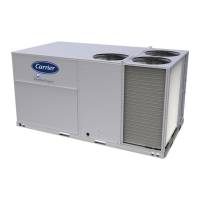38
Demand Control Ventilation —
Demand Control Ventilation (DCV) function requires a
space air CO
2
sensor be connected to the W7220
controller. The CO
2
sensor provides a 2 to 10 vdc signal
proportional to the space CO
2
level. This sensor is
available as a factory--installed option (located in the
unit’s return air plenum) or as a field--installed accessory.
See Fig. 1 for model number nomenclature; check
Position #9 for codes E, F, G or H indicating a
factory--installed CO
2
sensor. The W7220 automatically
recognizes the connection of this sensor and self--enables
the DCV function after the Configuration period.
VENTILATION FOR PEOPLE
VENTILATION FOR SOURCES
INCREASING VENTILATION
VENTMAX
VENTMIN
100 700
INSIDE OUTSIDE CO
2
DIFFERENTIAL
C12167
Fig. 48 -- DCV Single--Speed System Setpoints
DCV With Single--Speed Fan System: During DCV, the
outside air damper modulates between two user
configurations depending upon the signal level of the
space or return air CO
2
sensor representing the space
occupancy level. The lower of these two positions is
referred to as the Minimum IAQ Damper Position
(designated VENTMIN) while the higher is referred to as
Economizer Minimum Position (designated MINIMUM
POSITION or VENTMAX). The VENTMIN position
should be set to an economizer position that brings in
enough fresh air to remove contaminants and CO
2
generated by sources other than people; this airflow rate is
designated Va. The VENTMAX should be set to an
economizer position that brings in enough fresh air to
remove contaminants and CO
2
generated by all sources
including people at the design condition for maximum
space occupancy; this airflow rate is designated Vbz.
DCV With Two--Speed Fan System: Ventilation codes
require that the same ventilation rates (Vbz and Va,
expressed as CFM) be provided regardless of supply fan
speed. When the supply fan speed is reduced, the internal
static pressure in the unit’s return plenum also decreases.
If the same outside air damper position is retained, the
airflow rate through the OA damper decreases below the
Va and Vbz levels. To restore ventilation rates to design
levels, the damper positions VENTMIN and VENTMAX
must be automatically adjusted when the fan speed
changes. The W7220 provides this function when it is
configured for 2--speed fan operation through a second set
of damper position setpoints.
During operation at High fan speed, the damper setpoint
limits are designated VENTMIN H and VENTMAX H.
Damper operation is same as described under
Single--Speed Fan above.
During operation at Low fan speed, the damper setpoint
limits change to VENTMIN L and VENTMIN L. These
settings are higher than the comparable High speed
settings and cause the outside air damper to open more to
allow the same Va and Vbz airflow rates to be admitted to
the space.
Adjust the DCV setpoints VENTMAX H and VENTMAX L
with supply fan speed in High speed and Low speed
respectively to provide the design load ventilation airflow
rate Vbz by measuring outside air temperature, return air
temperature and supply air temperature. Make damper
position adjustments with at least 10_F temperature
difference between the outdoor and return--air temperatures.
VENTILATION FOR PEOPLE
VENTILATION FOR SOURCES
INCREASING VENTILATION
VENTMAX H
VENTMIN H
100 700
INSIDE OUTSIDE CO
2
DIFFERENTIAL
VENTILATION FOR PEOPLE
VENTILATION FOR SOURCES
INCREASING VENTILATION
VENTMAX L
VENTMIN L
100 700
INSIDE OUTSIDE CO
2
DIFFERENTIAL
HIGH SPEED FAN LOW SPEED FAN
C12168
Fig. 49 -- DCV 2--Speed System Setpoints — Same Ventilation CFM at Both Speeds
48HC48LC

